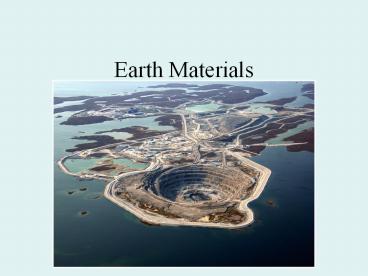Earth Materials - PowerPoint PPT Presentation
1 / 34
Title:
Earth Materials
Description:
Earth Materials Critical Thinking Which of the following materials are minerals, and why (or why not)? Water, beach sand, diamond, wood, vitamin pill, gold nugget ... – PowerPoint PPT presentation
Number of Views:24
Avg rating:3.0/5.0
Title: Earth Materials
1
Earth Materials
2
Objectives
- Explain the different kinds of bonds and describe
their influence on mineral characteristics - Define and distinguish between minerals and rocks
- List key properties used to identify minerals
- Identify most common mineral families and
accessory mineral families - Explain what holds rocks together
3
Elements and Compounds
- Element
- the most fundamental substance into which matter
can be separated using chemical means - Atom
- the smallest individual particle that retains the
distinct chemical properties of an element - Isotopes
- Atoms with the same atomic number but different
mass numbers
4
Elements and Compounds
5
Compounds, molecules and bonding
- Compound
- A combination of atoms of one or more elements in
a specific ratio - Molecule
- The smallest chemical unit that has all
properties of a particular compound
6
Compounds, molecules and bonding
- Bond
- The force that holds together the atoms in a
chemical compound - Ionic bonding
- Covalent bonding
- Metallic bonding
- Van der Waals bonding
7
(No Transcript)
8
(No Transcript)
9
(No Transcript)
10
(No Transcript)
11
Compounds, molecules and bonding
- Ionic Bonding
- One atom transfers electron to another, which
creates bond - Table salt (sodium chloride)
- Cubic lattice
- Moderate strength and hardness
12
Compounds, molecules and bonding
- Covalent Bond
- Electrons from different atoms pair up, which
creates a bond - Does NOT produce ions
- Strongest of chemical bonds
13
Compounds, molecules and bonding
- Metallic Bond
- Electrons shared among several atoms
- Outer electrons may drift between each other
- Typically good conductors of electricity
14
Compounds, molecules and bonding
- Van der Waals Bond
- Attraction between electrically neutral molecules
with asymmetrical charge - Form sheets
- Considered weak between sheets
- May feel slippery between sheets
15
What Is a Mineral?
- Mineral
- A naturally formed, solid, inorganic substance
with a characteristic crystal structure and a
specific chemical composition
16
What Is a Mineral?
17
Composition of minerals
- Crystal structure
- An arrangement of atoms or molecules into regular
geometric lattice. - Materials that possess a crystal structure are
said to be crystalline
18
Telling minerals apart
- Luster
- The quality and intensity of light reflection
- Metallic
- Vitreous
- Resinous
- Pearly
19
Telling minerals apart
- Hardness
- A minerals resistance to scratching
20
Telling minerals apart
- Crystal form
- Flat or planar surface that forms during the
growth of minerals - Crystal faces
- Habit
- The distinctive shape of a particular mineral
- Cleavage
- The manner in which a mineral breaks
21
Telling minerals apart
- Color
- Streak
- The thin layer of powder made by rubbing a
specimen on an unglazed fragment of porcelain - Density
- Reflection of compactness of atoms
22
Telling minerals apart
- Other mineral properties
- translucent, transparent or opaque
- birefringent
- magnetic
- luminescence or fluorescence
23
Mineral families and their uses
- Minerals of Earths crust
- Silicate minerals
- A strongly bonded, complex anion that contains
both silicon and oxygen - Oxide minerals
- Contains the simple oxide anion O2-
24
Mineral families and their uses
25
Mineral families and their uses
26
Minerals of Earths crust
- Rock forming minerals
- Polymerization
- The formation of a complex molecule by the
joining of repeated simpler units - Accessory minerals
- Less common minerals
27
(No Transcript)
28
(No Transcript)
29
Minerals of Earths crust
- Other mineral families
- Carbonate
- Sulfates
- Sulfides
- Phosphates
30
Mineral resources in modern society
- Ore deposits
- A localized concentration that can be extracted
profitably. - Mining
- Disturbs Earths surface
- Damage to environment
31
Rocks A First Look
- Rock
- A naturally formed coherent aggregate of minerals
and possibly other non-mineral matter - Record history of Earth processes
32
Rocks A First Look
- Igneous
- Form by cooling and solidification of molten rock
- Magma
- Sedimentary
- Form under conditions of low pressure and low
temperature near the surface - Metamorphic
- Altered by exposure to high temperature, high
pressure or both.
33
Rocks A First Look
- What holds rocks together?
- Partly mechanical, partly chemical
- May be caused by
- Compaction
- Solution
- Recrystallization
34
Critical Thinking
- Which of the following materials are minerals,
and why (or why not)? - Water, beach sand, diamond, wood, vitamin pill,
gold nugget, fishbone - Rock samples, taken from the Moon, contain many
of the same minerals as those found on Earth.
Why might this be the case? - Are there valuable ores being mined locally? If
so, what are the rocks and minerals of interest?































